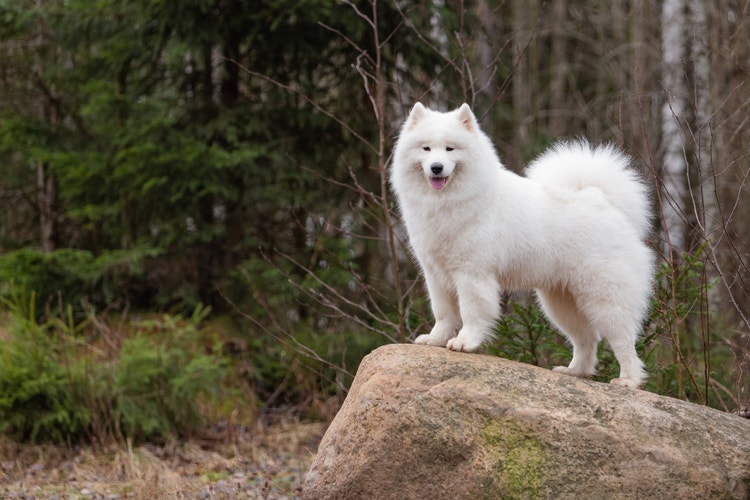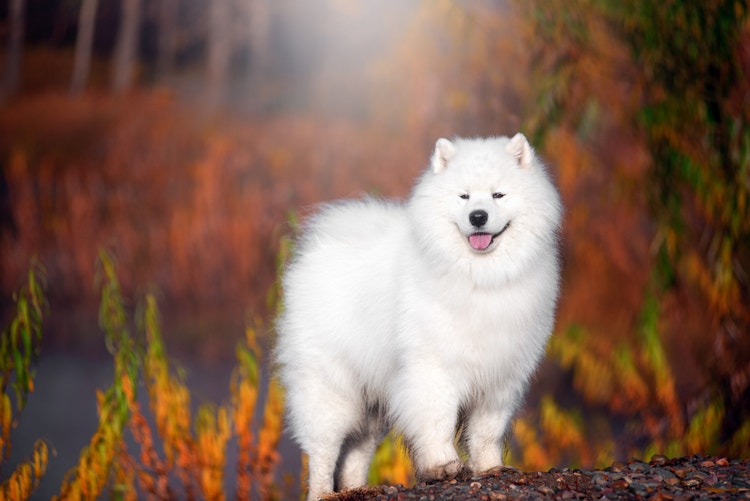
Samoyed


Where Are Samoyeds From?
The Samoyed was first reported in the 18th century as a working dog for the Samoedic people of northern Siberia. During the day, they were used to pull belongings from place to place, as well as herd reindeer. By night, they were watchdogs and companions that were kept inside their owners’ tents. Their luxurious fur was also used as clothing to keep their owners warm.
The breed reached England in 1889 via an explorer named Ernest Kilburn-Scott, and have since gained popularity. Samoyeds have been integral members of expeditions to the Arctic and Antarctic. They made their way to Australia after Scott used the breed in a South Pole expedition. Queen Alexandra was also a fancier of the breed, and the Samoyed has since made its way into American kennels. In 1906, the American Kennel Club registered its first Samoyed.
Caring for a Samoyed
What Kind of Diet Does a Samoyed Need?
What Kind of Diet Does a Samoyed Need?
The Samoyed should be fed a high-quality, age-appropriate diet. They can become overweight if their caloric intake is not properly monitored. Obesity can worsen arthritis or hip dysplasia, so it is ideal for your pet to maintain a healthy weight.
How Much Grooming Does a Samoyed Dog Need?
How Much Grooming Does a Samoyed Dog Need?
The Samoyed requires daily brushing to maintain their spectacular haircoat. Since their hair is thick, it can be difficult to bathe, so a dry shampoo should be considered instead. They are prone to mats if not properly groomed, which can lead to discomfort or skin issues. Routine nail trims are recommended for the breed, and shedding can become excessive once to twice a year.
Are Samoyeds Healthy Dogs?
Are Samoyeds Healthy Dogs?
The Samoyed is generally healthy, but there are some health concerns associated with the breed. As a deep-chested dog, they are prone to gastric torsion. Gastric dilatation volvulus is a condition that occurs after a large meal, when the stomach dilates as a result of gas and food. This type of emergency is life threatening.
They are also predisposed to hip dysplasia, which is a hereditary malformation of the hip joints. This can result in pain, lameness, and arthritis. Ocular diseases are also common, like glaucoma (increased pressure within the eye that can lead to pain and blindness), cataracts (loss of transparency in the ocular lens), and progressive retinal atrophy (degeneration of the nerves at the back of the eye). Routine ocular examinations by your veterinarian can help detect eye conditions.
The Samoyed’s life span is 12 – 15 years.
Samoyeds are predisposed to: gastric dilatation volvulus, hip dysplasia, cataracts, diabetes mellitus, glaucoma, progressive retinal atrophy, portosystemic shunt, renal dysplasia, aortic stenosis, nasal depigmentation, congenital deafness, arthritis, kidney failure, anal gland disease, dwarfism, and urinary tract infections.
How Much Training Does a Samoyed Need?
How Much Training Does a Samoyed Need?
The Samoyed is an intelligent, independent dog that can be easily trained if started at a young age. They demand attention and affection from their owners, and if not provided they can become destructive. They are a pack breed and establishing your alpha role early on is key. Early socialization is also recommended. Once trained, they are sure to become a loving and loyal companion.
How Much Exercise Does a Samoyed Dog Need?
How Much Exercise Does a Samoyed Dog Need?
The Samoyed requires daily exercise, either a long walk or play with family members. Always keep this breed on a leash! They are built for endurance and speed, with the ability to run for miles if given the chance. The Samoyed’s haircoat is built for the Arctic and should be monitored closely in warm climates. They have a tendency to overheat in hot weather and should not be exercised heavily or kept in the heat for long periods.
What Are the Physical Characteristics of a Samoyed?
Samoyed Facts
Other Breeds to Explore
References
- Morris, Desmond. Dogs: The Ultimate Dictionary of Over 1,000 Dog Breeds. Trafalgar Square, 2002.
- American Kennel Club. The Complete Dog Book. Random House Digital, Inc., 2006.
- Wilcox, Bonnie and Chris Walkowicz. The Atlas of Dog Breeds of the World. T.F.H Publications, Inc., 1995.
- Samoyed Dog Breed Information. American Kennel Club, 2020.
- AIS/PennHIP FAQ. ANTECH Imaging Services, 2016.
- What is Canine Hip Dysplasia?. Orthopedic Foundation for Animals. 2020.
- Gastric Dilatation-Volvulus. American College of Veterinary Surgeons. 2020.


